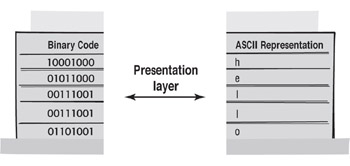Layer 6: The Presentation Layer
The Presentation layer of the OSI model is responsible for:
-
Character code translation
-
Data encryption
-
Data compression and expansion
Character Code Translation
Extended Binary Coded Decimal Interchange Code (EBCDIC)
The 8-bit character set used by IBM mainframes.
People understand symbolic characters; for example, 'hello.' Computers understand data as a series of ones and zeros (binary code). In order to communicate, there must be some translation. This process occurs at the Presentation layer of the OSI model through character code translation. Examples of character codes include:
-
ASCII
-
EBCDIC
After data moves from the Application to the Presentation layer, it must be converted from its original form to a format that will be understood by the receiving device. As noted above, this format may be in ASCII or it may be in EBCDIC. The data may also need to be encrypted or compressed before being passed on to the Session layer.

Data Encryption
Data encryption is the process of encoding data so that it is protected from unauthorized access. Some of the methods used to encrypt data include:
-
Transposing information within the data.
-
Substituting one character for another. (Think of this as the secret code you used when you were a kid.)
-
Scrambling the data with mathematical calculations that the sender and the receiver determine. This is the most secure encryption method and is the most complex. Almost all Internet sites that have security use this method.
Data Compression and Expansion
Data compression occurs at the sender's end and compacts the data so that it can be sent more efficiently.
Data expansion, or decompression, occurs at the receiver's end when the data is returned to its original format.
distributed processing
Sharing the task of processing instructions between a server and a client CPU.
| Note | There are many encryption methods that can be implemented at the Presentation layer. Some encryption methods are easily broken using available software. On the other hand, the most complex encryption methods are considered so vital to national security that the U.S. government restricts or bans exporting the technology. |
|
|